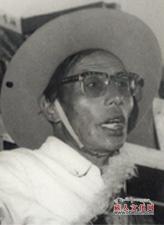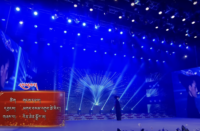
It’s morning. An old Tibetan man approaching his eighties lights some incense, prays, and begins reciting the epic Tibetan classic poem, Gesar, into a worn-out old tape recorder. “Almost every night for the past sixty years, I dream about Gesar. The next day, I record the stories I dreamed from the previous night,” the old man told a reporter.
This old man is the famous Gesar bard Tsering Wangdu, and the story of how he went from vagabond to “national treasure” is a legend in itself. And in today’s modern environment, with its increasingly fast pace of life, he has his own ideas for how to pass on Gesar culture to future generations.
From Vagabond to “National Treasure”
Tsering Wangdu was born to a poor herder’s family in Nagchu, Tibet, in 1933. Both of his parents passed away before his tenth birthday. In accordance with his mother’s last wishes, little Tsering Wangdu went to Mount Kailash to pray that his parent’s souls could attain enlightenment. It was then he began living as a nomad for over ten years.
“During those years, I worshipped at virtually every temple in Tibet. Towards the end, I prostrated around Mount Kailash, Mount Nyenchen Tanglha and Lake Namtso a full 13 times before attaining perfection,” Tsering Wangdu said.
Tsering Wangdu told a reporter that one day, he unwittingly fell asleep on the banks of Lake Namtso. “I had a very long dream. The whole dream was about the story of Gesar.”
“After that, I continued wandering for many years — until 1957 when I started a family and became a herder in the Tangla area of Qinghai Province. Every so often, I told stories to the villagers there,” Tsering Wangdu said.
His fate changed in the 1980s, when the government designated preserving the Gesar epic as one of the key projects of the 6th and 7th Five Year Plans. In 1987, the Qinghai Province Gesar Research Association conducted a one-time comprehensive study of Gesar performers. As a result, Tsering Wangdu was discovered and quickly hired as a bard. He went on to receive such titles as “Gesar Bard”, “State Council-subsidized Expert”, “Outstanding Purveyor of The Gesar” and more.
As of recently, Tsering Wangdu has recorded eleven rare works, including “Athar Shardzong”, “Five Auspicious Wishes”, and “The Battle of Rhino Ridge”, all of which were previously in danger of being lost to history. In words, his recordings represent over three million characters.
Fears of “Losing The Art along with The Artist”
The Gesar, which has been labeled the “Iliad of the East”, took form around the 10th century AD, and it was passed down orally throughout the generations. It developed into a massive, roughly 20 million-character-long work — a number that surpasses the length of all of the “Four Epics” combined. The Gesar epic is also one of the world’s few remaining “living epics” that folk artists continue to perform and pass on by oral recital.
Tsering Wangdu admits that along with the increasingly fast pace of modern society, Gesar culture faces a dwindling audience. “Nowadays, young Tibetans listen to popular music, watch blockbuster films — There aren’t many young people who actually want to listen to me sing anymore.”
Tsering Wangdu also believes the limited impact of his art form outside of Tibetan areas represents another inhibiting factor to the proliferation of Gesar culture. “Now, there are more and more people interested in Gesar, but for the most part its impact is limited to academic circles.”
Tsering Wangdu believes it is not enough to rely solely on recordings to preserve, protect and develop Gesar culture. “Another fascinating aspect of Gesar is the interaction between the performer and the audience. If it were possible to record the scene of the performance, it would aide research into Gesar,” Tsering Wangdu said.
Preservation and Development on Multiple Levels
Tsering Wangdu told a reporter that today’s young “Gesar” performers integrate modern stage techniques into their performances. “Performers wear armour, hold whips — It’s as if Gesar himself has come down to the realm of humanity. The audience loves it.”
In recent years, a Chinese language version of Gesar steadily made progress towards publication. A Chinese language version of the epic poem, translated by the Qinghai Province Gesar Research Association, was published by a university-affiliated publishing house at the beginning of this year. Around the same time, Gansu Ethnic Publishing House recently released “The Gesar Children’s Literature Series”. “The more complete the Chinese editions are, the better. I hope more and more people enjoy ‘Gesar’ through reading,” Tsering Wangdu said.
Tsering Wangdu also added, “Children today love Harry Potter. I believe Gesar is much more imaginative than Harry Potter. Gesar can be made into a feature film or animation, and this would cause more children to fall in love with the story.”
Finally, Tsering Wangdu concluded the interview by emphatically sharing this thought to a reporter: “I’m old, but I’m not old-fashioned. As long as something is good for the preservation of Gesar culture, I’m in favour of it. The Gesar story must be passed on to every generation to come.”
Original URL: http://people.tibetcul.com/dangdai/ysml/201206/29917.html





Follow Us!